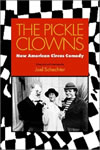 |
 |
 |
 |
![]()
Volume 6,
Issue 3, Spring 2003
|
The Pickle Clowns: New American Circus Comedy Schechter, Joel (Editor)Southern Illinois University Press, 2001 175 pages Paper: US $25.00 |

|
Reviewed by: Alexandra
M. Merceron, Emerson College
Printer-friendly PDF
version
Joel Schecter's The Pickle Clowns: New American Circus Comedy looks at the life and times of the famed circus clown troupe and their major contribution to American performance art. The book approaches the illustrious family of clowns' work with a seriousness that moves them out from under the "big top" and into the realm of significant and vital American artists.
Unlike the warm, fuzzy and nostalgic approach of other books on the subject, Schechter's book takes an empathetic and academic approach to documenting the career and legacy of the Pickle Clowns. Through a series of personal interviews and a retrospective of their groundbreaking career from the mid-seventies through present day, the book studies the Pickle Clowns as some of the most influential artists in their highly complex medium and as a stage family full of pride and tradition. The result is the perfect balance between biography and memoir from the Pickle Clowns unique perspective.
Schechter's interviews with the Pickles delve into little known details of their acclaimed comedy acts and circus shows, giving readers a rare look behind the costumes and make up. From them, readers get insight on the complexity of clowning and how it elicits deep-seated audience engagement of the most natural kind. The Pickles' work is a testament to the purity of the clown-audience relationship, which raises questions about the future of clowning in the digital age. Is the circus a dying institution among today's audiences or is the Pickle Clown's style of entertainment still raw and dynamic enough to enthrall children of all ages?
Schechter also uses the Pickle Clowns' story to make a compelling case for the broader inclusion of circus clowning in the study of American performance art. With what is clearly a passionate and deeply personal vesting in the matter, the author explores the longevity and relevance of clowning as an art form and cites its influence on many of history's more traditional stage and screen comedians. Using the Pickles as an example of that widespread and timeless influence, he elevates the clown to the level of artist-hero, painting these often overlooked underdogs of the performance world as willing journeymen lugging their act from town to town for the good of society.
In all, Schechter pays tribute to the Pickle Clowns with empathy, gratitude
and reverence. And, whether one has experienced the work of the Pickle
Clowns or not, he makes their contribution to the American circus and
the world of performance art clear: after nearly three decades the Pickle
Clowns remain synonymous with the modern American circus and their work
demands to be included in any worthwhile assessment of American performance
art.
Back to Top
Home | Current
Issue | Archives | Editorial
Information | Search | Interact